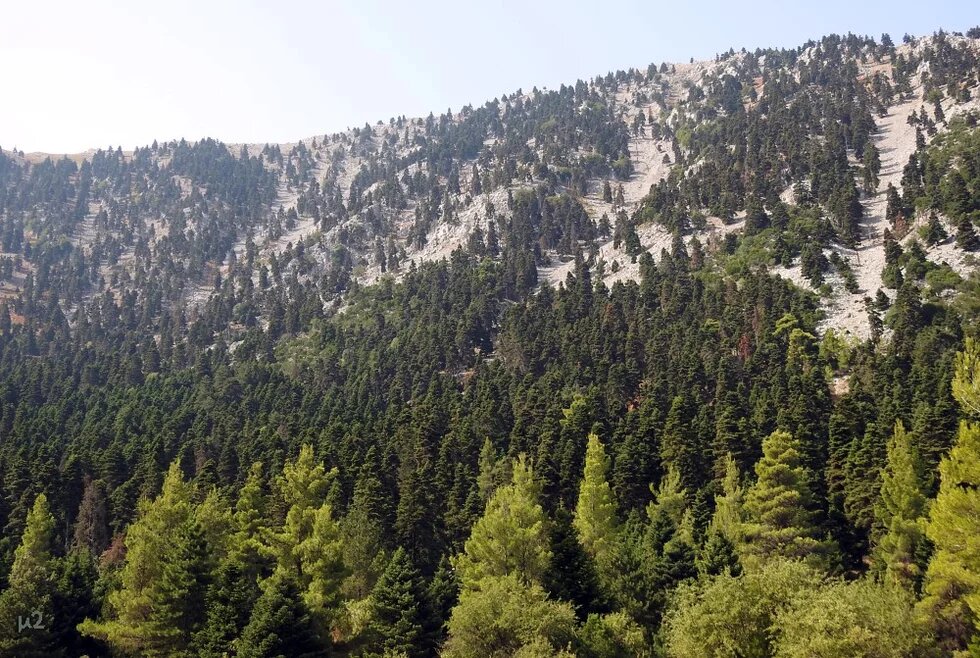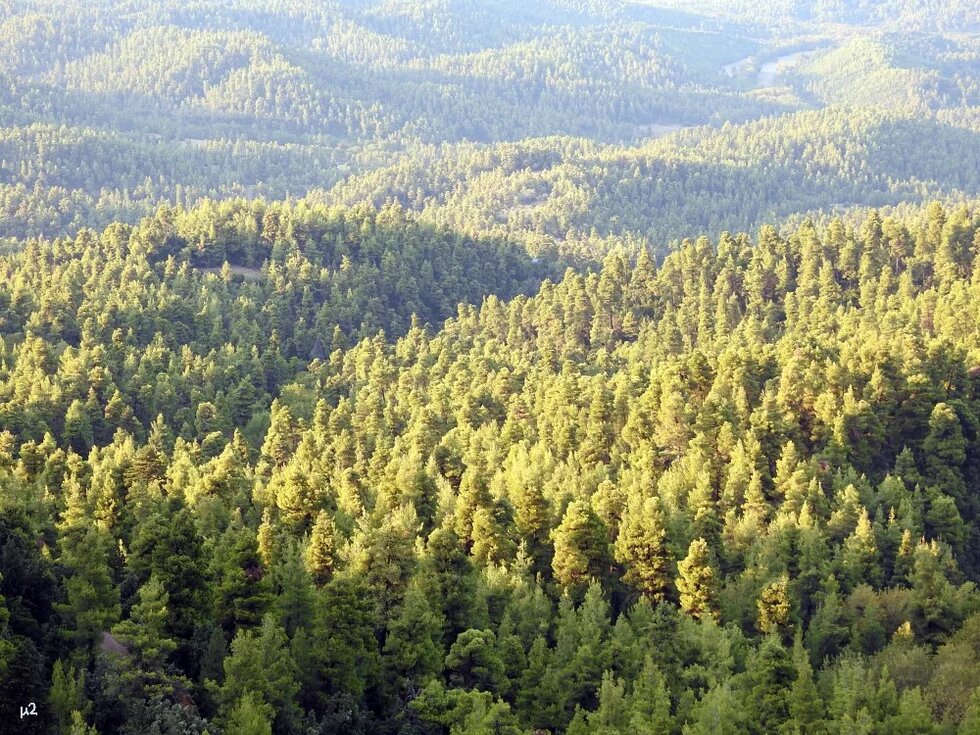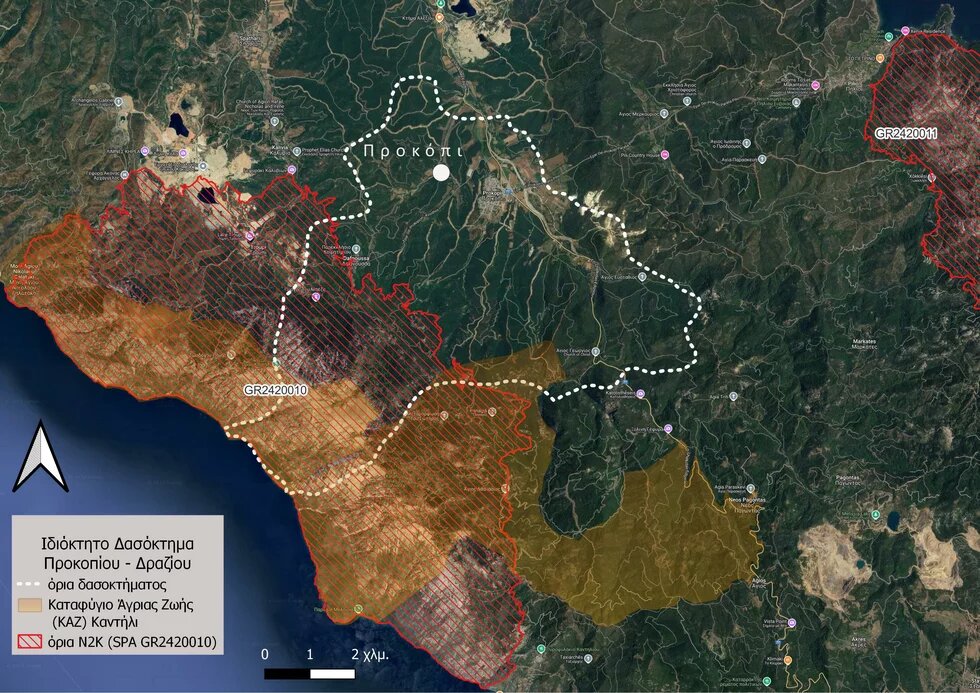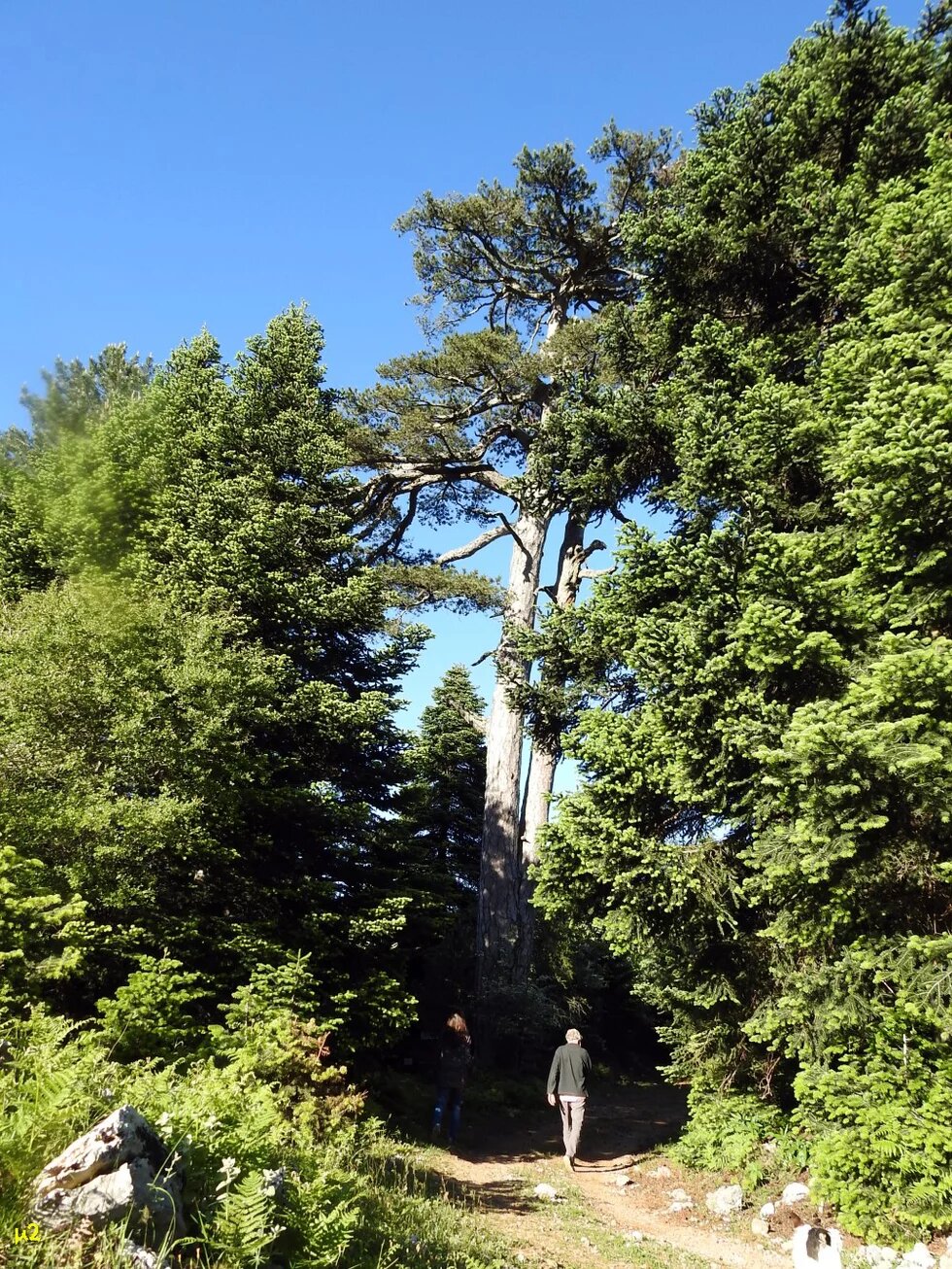
A very large part of Greek forests is not publicly owned and as far as its proprietary status is concerned, it is classified as private, co-owned, possessed, jointly possessed, communal, or monastic property. By following the long story of one such non-public forest area –the Prokopi-Drazi Forest or Baker Forest in Northern Evia– we can essentially follow the entire history of the Greek state: its dysfunctions, inequalities, foreign dependencies, the lack of a cohesive and consistent forest policy, but also the social struggles. After the devastating wildfire on the island in 2021, the Prokopi-Drazi Forest, which miraculously survived, now stands as a valuable reserve for the future restoration of Northern Evia’s forests.
*The following article is a shortened version of a more extensive historical review, which you can find in PDF format (in Greek) at the end of the text.

The history of the Baker Forest in Evia begins at the distant year of 1832, when two young friends, Edward H. Noel and Friedrich Rudolph von Fellenberg, embarked on an adventure to establish an agricultural school in Greece, modeled after the Hofwyl agricultural school in Switzerland, from which they had just graduated.
The land chosen for this school was the manor known as “Ahmetaga”, located about 48 kilometers from Chalkida, in a particularly remote and sparsely populated area. There was no actual settlement, but around 20 families lived there in scattered huts on the forested slopes (Noel-Baker 2003).
Initially, 6.000 hectares were purchased for the price of £10,000, although other sources cite an even lower amount of £2,200 (Noel-Baker 2003). This area included extensive forests as well as agricultural land, with ownership rights confirmed by the then-owner of Ahmetaga, Haci Ismail Bey who was also the Ottoman government's representative responsible for overseeing the transfer of Turkish estates in Attica and Evia following the establishment of the Greek state and the compulsory departure of the Ottomans (Noel-Baker 2003).
The definitive incorporation of Evia into Greece took place only in March 1833, under the government of King Otto. Doubts regarding the validity of the land sale contracts had already begun to appear as early as 1833, prompted by questions from Mavrokordatos, who was the Greek government's Minister of Finance. A century and a half later, the same question would emerge (Noel-Baker 2003). Mavrokordatos' circular stated that “no private individual shall be granted land ownership rights, but only the exclusive right of cultivation”. As a result of Mavrokordatos' actions, properties were confiscated, and many owners were prohibited from using pastures. The cultivation of various large estates was abandoned, and large capital funds fled the country.
The year 1834 found young E. H. Noel at a dead end, having invested most of his funds in the purchase of an estate which he was not sure whether he owned or not and for this reason he ultimately abandoned all his agricultural plans. That same year, Friedrich Rudolph von Fellenberg passed away, and their other partner, Karl von Müller, had already returned to his homeland.
However, in 1835, Noel was granted a logging permit (Noel-Baker 2003), which enabled him to repay the loan for the purchase the Ahmetaga estate, while in 1836, the issue of the forest lands was resolved, and in 1837, ownership of the forest was officially recognized by the commission overseeing the sale of Turkish properties (Noel-Baker 2003). Encouraged by this development, Noel went on in 1839 to purchase from Bracebridge the neighboring estate in Drazi (Dafnousa), previously known as “Hodjeti”, covering approximately 1.000 hectares for the sum of 40.000 gold drachmas.
The exploitation of the forest and its challenges
From the time of his initial settlement in Ahmetaga, E. H. Noel had foreseen that the forests of Northern Evia could become a significant source of wealth to contribute to the substitution of imported construction timber from Trieste and to the supply of Syros’ shipyards with essential raw materials. In 1836, after resolving the legal uncertainty surrounding the proprietary status of the forest lands, he recognized the opportunity presented by the favorable circumstances of the building of Athens as the new capital of the kingdom, to sell construction timber, and he didn’t let it go unexploited. Being optimistic that he would be able to supply this demand at prices lower than those of timber imported from abroad and, thus, reap a substantial benefit, he enthusiastically threw himself into logging.
However, by the mid-19th century, he had abandoned any form of exploitation of his forest land as unprofitable, no longer bearing the expenses, the excessive strictness of the forest officials against him, and their constant financial demands. In fact, even the construction timber he needed for his own estate often ended up being cheaper when transported from Syros than when sourced from his own forests in the area! Despite its superior quality, his construction timber could not easily compete with the market penetration of the imported timber from Trieste, as it was burdened with a higher tax rate (10%–14%), even though it was intended for domestic consumption.
As if all this weren’t enough, in September 1877, a major wildfire burned down a very large part of the Ahmetaga forest and since then, for the next two or three years, it became evident that clearing and cultivating forest land was ultimately more profitable than preserving it.
The two partners, however, had another source of income which was magnesite, or white stone. As early as 1845, K. von Müller had sent samples to England to explore the potential of exploiting the deposits. He was the first to undertake this work, which later proved crucial for the industrial development of Evia. The discovery of these mineral deposits provided them with an additional enterprise, though once again, there were costs involved in mining operations (such as road construction, a bridge, carriages, oxen, etc.) In 1889, however, the Noel family sold the magnesite mining rights to the Anonymous Company for Public and Municipal Works (ACPMW), the predecessor of the later Skalistiris Group, an operation that weighed on the forest estate for many decades (Management Study 2010).
By 1867, the two friends had withdrawn from the forest estate's administration and passed it on to their sons. By 1870, all shares had come in the ownership of Frank E. Noel.
Stabilization and the formation of the Noel-Baker family
In 1889, three years after the death of E. H. Noel, the estate reached its peak size of 9,000 hectares, including forests, pastures, and cultivated land. The Drazi property had already been purchased from Bracebridge, and in 1889, the settlement of Farakla which by then belonged to the Greek shipowners Gourdis and Tombazis from Hydra, was also acquired (EDC 1990).
This period in the forest estate's history is considered the most peaceful. Frank Noel enjoyed a good reputation among the local population for his work as a doctor. His daughter, Irini, a volunteer nurse during the Balkan Wars and World War I, was decorated for her service to Greece. In 1915, she married Philip Baker, and from then on, the family name became Noel-Baker. After the death of Irini Noel-Baker, the entire agroforestry estate was passed by will to her son, Francis Noel-Baker, and his two sons, Edward and Martin, as equal co-owners in indivision.
Refugees and land expropriations
In 1925, following the population exchange after the Asia Minor Catastrophe, refugees from the town of Urgüp (Prokopi), near Nevşehir in Cappadocia, settled in Ahmetaga. Specifically, 220 families arrived, living in tents until 1927, when the first 100 refugee houses were built by the Settlement Authority. Living conditions were extremely harsh. Most refugees had no jobs, water was scarce, and malaria caused many deaths. So, by the end of 1925, more than half had already left the village, prompting the government to bring in refugees from Muğla (Stellakou 1999).
In 1928, the Expropriation Committee of Chalkida declared 550 hectares of farmland within the estate as subject to expropriation in favor of the native residents of Prokopi. Irini Noel-Baker chose not to exercise the exemption of her forest estate from expropriations, as a privilege granted to her due to her humanitarian work (Greek Forests 2010). These fields were distributed to both the refugees and the landless local people, who until then were sharecroppers.
In 1939, Irini Noel-Baker sold her farmland in the Drazi area to its inhabitants, an area of 645 hectares. Thus, the total area of agricultural land enclosed within the forest estate reached 1.195 hectares, many of which later remained uncultivated. The expropriation process was completed in 1955 when another 518.8 hectares were distributed to local growers (EDC 1990).
The Northern Evia Foundation, Pattakos, and the consequences
Philip Baker and his son Francis Noel-Baker, both Labour MPs in Britain, founded the Northern Evia Foundation in 1961 with the aim of assisting the island’s impoverished residents. They raised funds through donations and charity events in England and sent them to Evia for doctors, veterinarians, foresters, agronomists, and other specialized personnel to help develop the area. The Foundation’s work was significant, though it proved short-lived, because by 1969, it was already facing financial difficulties, prompting Francis Noel-Baker to invite dictator Pattakos to the estate in an attempt to persuade him to have the state take over the Foundation's funding. His public support of the military junta was ultimately his biggest mistake.
After the restoration of democracy (Metapolitefsi), on May 9, 1975, “the entire region rose up against the English oppressor”, as newspapers of the time reported. The May 9th Association, which included most residents as well as thousands of Greeks from outside Evia, demanded the redistribution of the 4.500-hectare estate: farmland for the landless, plots for the residents, and the forest for the state.
In 1975, the Council of State ruled that the decisions of the committee on the sale of Ottoman properties did not constitute, in the case of forests, acts by the State recognizing private ownership and the Ministry of Agriculture classified the Baker Forest Estate as adverse possession, given that there was no official administrative decision recognizing the Bakers’ ownership (Management Study 2010). Forests subject to adverse possession belong to a sui generis category of forest land, where ownership remains unresolved for various reasons and the land is occupied by private individuals.
The long-running legal dispute
Following the decision to classify the forest estate as adverse possession, the family filed a claim in 1976 with the then Ministry of Agriculture. Nearly a year later, in 1977, the Deputy Minister of Agriculture, based on a relevant opinion from the Council on Forest Ownership, ruled that the Prokopi–Drazi agroforestry estate was privately owned and belonged indivisible to Francis, Edward, and Martin Noel-Baker in one-third shares. In fact, an official protocol for the handover and takeover of the property to the recognized owners was also drawn up.
The next turning point came in 1983, when the Ministry of Agriculture issued an order revoking the protocol for the handover and takeover of the property, while at the same time a request to the Forest Ownership Review Council (FORC) to re-examine the ownership status of the forest. Subsequently, FORC accepted by majority vote that the Baker family had no ownership rights over the forest estate, and that these forest lands should be managed as public property. As a result, in 1984, following a decision by the Minister of Agriculture, the forest had been declared public.
The Bakers immediately filed a declaratory lawsuit before the Multi-Member Court of First Instance of Chalkida for the now publicly declared Prokopi-Drazi Forest.
After legal battles by the family and successive decisions by the competent authorities, the ownership of Francis Noel-Baker and Edward Noel-Baker over an indivisible two-thirds share of the entire forest estate was ultimately irrevocably recognized by the Supreme Court of Greece in 2004. A final and binding decision recognizing the Bakers’ ownership came only in 2017, and it was rendered irrevocable by the Supreme Court in 2019.
The present and the future – under the threat of wildfire
Today, things have finally stabilized. In the immediate area of the privately owned forest there are three settlements: Prokopi (with 948 residents), Dafnousa (with 58 residents), and Troupi (with 16 residents). A significant number of the residents of these two communities were employed in the local white stone mines. In recent years, when the mining operations ceased or were significantly reduced, the area’s workforce faced an employment problem. It was then that the Agricultural Forestry Cooperative of Prokopi-Dafnousa was established, engaged in logging operations and the resin tapping from the pine trees. Today, there are two active Forestry Labor Cooperatives, FLC Prokopi-Dafnousa (with 35 members) and FLC Kireos. Part of the local workforce is employed in agriculture, while very few work in livestock farming. At the same time, there has been a rapid increase in tourist traffic in Prokopi, partly due to its location, even though the relatively remote Dafnousa has not experienced the same phenomenon. Prokopi, situated on the Halkida–Northern Evia highway, receives a very large number of tourists who come to visit and venerate the shrine of Saint John the Russian. For this reason, a significant part of its economy relies on tourism, with many tourist shops, taverns, restaurants, etc., where a considerable number of people are employed. (Management Study 2021).
In the meantime, the owner of the forest estate had already spent large sums before 1966, primarily for the creation of firebreaks with a total length of 64 kilometers, as well as for their periodic maintenance. He also continued to invest in the development of a road network totaling 110 kilometers, along with its maintenance, so that in the event of a fire, firefighting crews could arrive on time. Additionally, funds were periodically allocated for shrub clearing, blockages, and cleaning of the highly flammable forest subfloor while a significant amount was also spent on the construction of a fire lookout station located just below the mountain top of “Agortza”.
After 1985, when the forest came under state ownership, the state continued efforts to protect it against fire by opening new forest roads, maintaining existing roads and firebreaks, and carrying out pruning and shrub-clearing operations.
However, as clearly demonstrated by the 2021 wildfires that ravaged Northern Evia and reached the borders of the forest estate, the risk of wildfire is and will continue to be very high. Therefore, efforts must continue, and additional measures should be taken to further protect the forest from what is perhaps the greatest challenge it has faced in its long and eventful history.
BIBLIOGRAPHY
- Gouzioti, K., 2019. Asia Minor Refugees in Evia. Master’s thesis, Department of Primary Education, Division of Humanities, Athens, 2019.
- Dimitriadis, S., 2018. The Landowners of Evia in the 19th Century. Department of History and Archaeology, School of Philosophy, National and Kapodistrian University of Athens, Doctoral Dissertation.
- Management Study 2021. Management Study for the Decade 2021–2030. Private Forest Estate of Prokopi-Drazio. Hellenic Forests G.P. & Olympus PCC, 2021.
- Management Study, 2010. Management Study for the Decade 2010–2019. Co-owned Forest of Prokopi-Drazio, under the jurisdiction of the Forestry Service of Limni, Evia. Hellenic Forests G.P., 2010.
- EDC - Ecology & Development Company, “Agenzia per la ricerca, la documentazione e l' educazione ambientale”, 1990. “Program for the Creation of a Natural Park in the Kandili Area of Evia”. Commission of the European Communities, Contract No. 6613 (87/02), Final Report.
- Balta, E., 2009. The Recording of Asia Minor Settlements in Evia by the Center for Asia Minor Studies (1948–1964). Archive of Evian Studies, 38/2008–2009.
- Papagiannis, G., 2011. Forest Ownership. Nomiki Bibliothiki, Athens, 2011.
- Stellakou, V., 1999. The Refugees of Cappadocia in Greece: Socio-Cultural and Functional Dimensions in the Human-Built Environment Relationship. University of the Aegean, Laboratory of Environmental Design, Department of Environment, Mytilene 1999. Doctoral Dissertation.
- Noel-Baker, B., 2003. An Island in Greece: The Noel-Bakers in Evia. The Friends’ Publications, Athens, 2003.
- Reber, K., 2001. Letters from Ahmet-Aga: Landowners from Switzerland in 19th Century Evia. Available at: Academia.edu (reprint from Archive of Evian Studies 33/1998–2000, Evian Studies Society, Athens 2001, pp. 339–351), accessed December 2024.

